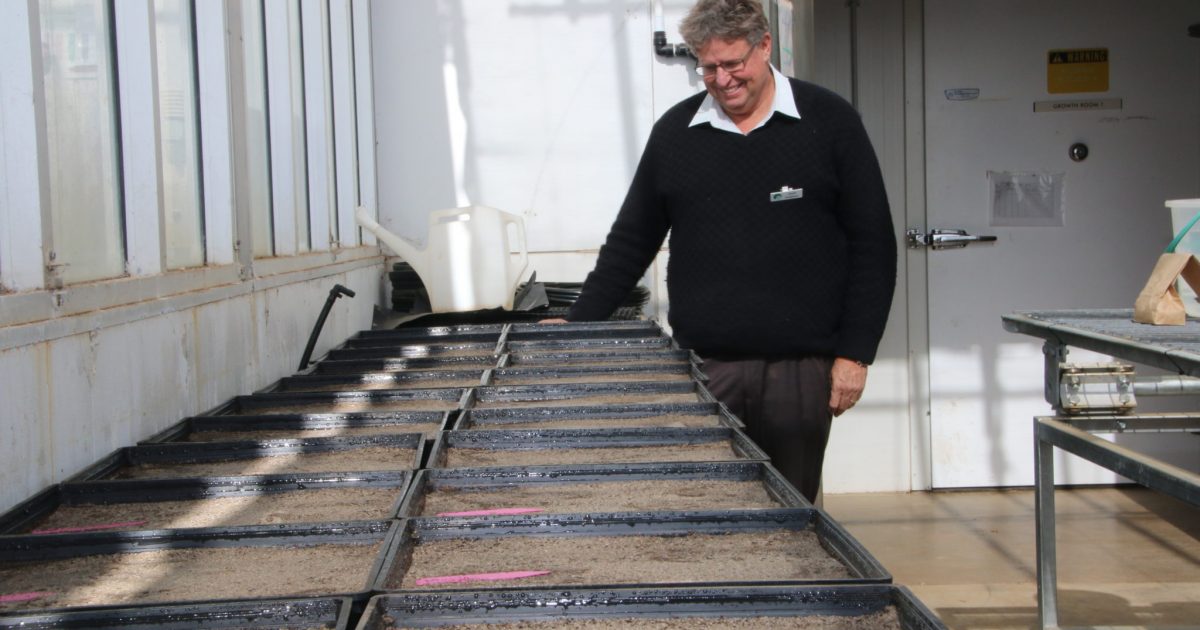Ground breaking grains research on the use of new seed and fertiliser coating technology to overcome soil constraints has generated revealing results, which could help growers improve crop potential and profitability.

The Department of Primary Industries and Regional Development project has been investigating the use of a seed coating to overcome soil water repellence, as well as an elemental sulphur coating for phosphate fertilisers.
Development officer Geoff Anderson said the seed coating trials were tested to the full by a dry start to the season and produced some outstanding results.
A barley trial at Darkan and a wheat trial at Badgingarra tested seed coated with a surfactant, a substance that helps to provide a more favourable soil environment for germinating seed.
The trial compared plant responses to seed coated with the surfactant, with surfactant applied in-furrow with the seed, on top of the furrow and a control treatment with no surfactant.
Dr Anderson said while there was relatively little difference in the plant responses to the seed coating and the in-furrow surfactant applications at the Darkan barley site, both were significantly higher than the control.
“Plant densities were 34 to 50 per cent higher than the control, where the surfactant had been applied to either the seed or the soil,” Dr Anderson said.
“The highest plant density of 145 plants per square (p/m²)metre was achieved with the soil surfactant applied on top of the furrow, at a rate of five litres per hectare.
“The seed coated with soil surfactant at a rate of 0.1 per cent of seed weight achieved plant densities of 129p/m², compared with the control at 97p/m².”
The Badgingarra wheat site was more established when measured so Dr Anderson and his team compared tiller numbers and biomass responses.
“The highest tiller number of 100 tillers per square metre was achieved with the surfactant placed on top of the furrow at 5 litres per hectare, followed by the seed coated with 0.5 per cent surfactant with 97 tillers/m2, while the control achieved 37 tillers/m2,” he said.
“This higher tiller number carried through to higher biomass with the surfactant placed on top of the furrow with 2.9 tonnes dry matter (DM) per hectare, followed by the seed coated with 0.5 per cent surfactant with 2.2t DM/ha, while the control achieved 1.5t DM/ha.
“Improved biomass growth resulted in increased soil nitrogen uptake, which was reflected by the biomass mass nitrogen content. The in-furrow treatment recorded 81 to 89 kilograms of nitrogen (N) per hectare and the coated seed 74 to 75kg N/ha, which was significantly higher than the control of 54kg N/ha.”
The researchers are also conducting glasshouse experiments to better understand how the surfactant seed coating improves wheat and barley germination in water repellent soils.
Dr Anderson said trial results showed there was great potential for the application of seed coating technology to overcome soil water repellence and boost yields.
“Seed coating at a rate of 0.1 per cent equates to an application volume of about 65 millilitres per hectare, compared with the in-furrow treatment of up to 5000ml per hectare,” he said.
“Given the plant responses, the technology could provide an ‘insurance policy’ in dry years to assist growers to optimise yield potential and may provide an alternative, cost effective approach for growers to manage water repellent soils.”
The project also evaluated the potential for the use of phosphate fertilisers coated with elemental sulphur to aid sulphur deficient canola crops at a trial at Moora.
Mr Anderson said while the results were not as positive, they were still encouraging.
“The best biomass result of 3.69t DM/ha was achieved with ammonium sulphate applied in-furrow at seeding at a rate of 10kg DM/ha, followed by triple super (TSP) coated with elemental sulphur with 2.39t/ha, compared with the control of 2.15t DM/ha,” he said.
“The dry start to the 2017 season was not an ideal season to test elemental sulphur coating, as it requires moisture to oxidise into sulphate sulphur. If there had been a wetter start to the year with sulphur leaching, the fertiliser coating may have performed better.
“More research needs to be done to assess the plant responses in different seasonal conditions.”
An economic analysis of the results of the seed and fertiliser coating trials will be undertaken once yield results are collected after harvest.
The two-year Flagship trial is part of the department’s Boosting Grains Research and Development project, supported by Royalties for Regions, and is supported by the Grains Research and Development Corporation.


